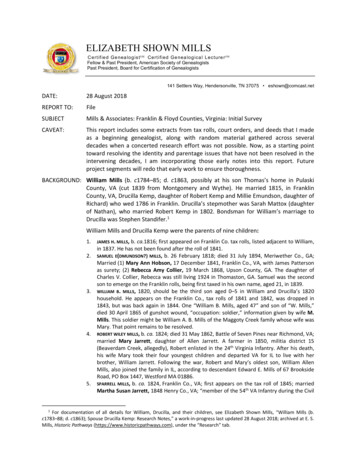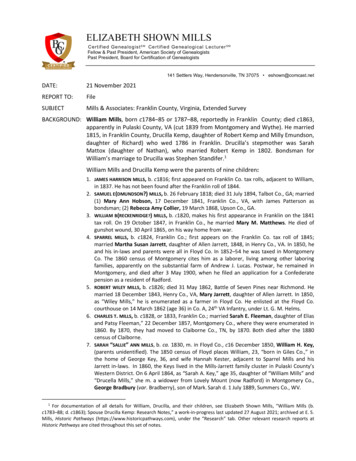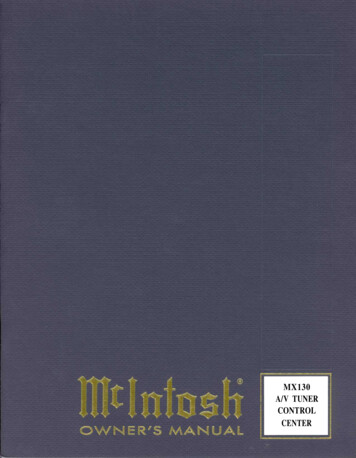
Transcription
mills. Flaker. belnder.OPERATING INSTRUCTIONS FORMILLS AND FLAKERS1
INDEX4safety instructions for komo devicesinstructions15general operation of the flakeroperation Flocinooperation Flicflocoperation Electric flakergeneral operation of the millsoperation manual milloperation of the electrical milloperation combined devicesoperation flour sifter17operation interchangeable milling18troubleshootingto try outfurther informationwarranty terms678910111214For more than 30 yearsWe would like to thank you and are glad that you have decided to purchase a product from our company. Youwill enjoy your solid device for a long time, since it has been produced by hand with an impressive love forthe detail from best materials. Please thoroughly read these operating instructions before using the devicefor the first time. There you will find all information for a safe operation.We wish you to enjoy preparing your fine dishesMarcel and Peter Koidl21920233
safety instructions forKoMo devices1. Please thoroughly read theoperating instructions and follow theincluded notes.2. Connect your electrical device only toa suitable power socket. Check if the datawhich are indicated on type plate complywith your power grid. Do not use any multipleplugs or extension cables.3. Only use the device if all associatedparts are in perfect condition.4. Only use purified raw food. Non-purifiedraw food often contains small stones andimpurities, which might damage thedevice.5. Your KoMo device is mainly made ofwood.Thismaterialreactsonenvironmental influences. Climate andtemperature fluctuations might result in smallfractures. This does not impair the function. Do notplace the device in proximity to radiators or thestove and avoid places with direct solar radiationin order to protect the housing at the best.46. Our devices are engineered for grindingof normal household quantities of grainto flour, flakes and grist and it is notintended for commercial use. The exception areour professional devices.7. They must only be operated by adultswho are physically and mentally ableto operate the devices and who havecompletely read these instructions.8. Switch your device off when it is nolonger used.9. Before opening the device the powerline must always be disconnected! Riskof injury by mobile parts and risk ofentrapment!10. Place your device during use on a hardsupport (e.g. a kitchen counter). It willguarantee that the slots at the bottom of thedevice will be free to ventilate the motor.11. Do not use the device outside, inhumid rooms or nearby open watercontainers. The device must not get wet.16. If the power cable of the device wouldget damaged, it needs to be replaced bythe manufacturer, his customer service ora qualified person.12. Make sure to collect the grist or flakeswith a sufficiently large container, so thatthe grist or flakes do not get jammed inthe outlet.17. Keep the device away from liquids,heat, open flames and humid rooms.13. Before using the device, check withthe overview of grist in the attachedbrochure or under www.komo.bio, if thedevice is suitable for the desired raw food.14. Insofar as the device is screwedtogether and can only be opened withtools, only our customer service is allowedto open it. In case of disregard, the warrantybecomes null and void. No tools are required forcleaning. This applies except for the disassemblyof the millstones for maintenance and cleaningpurposes. Observe the instructions in this manualfor the disassembly.18. The manufacturer cannot be heldliable for damages, which are caused byimproper use or wrong operation.19. Never leave the appliance unattendedduring operation.15. Do not use the cable to pull the plugout of the socket, but directly pull on theplug and do not place the cable on sharpedges.5
General operation of theflakeroperationFlocinoAssembly1. Fix the flaker to a table plate or similar meanswith the help of the two screw clamps.2. Then turn the hand crank clockwise.3. Finally put on the hopper with the adapterpiece and the hopper lid.What materials can be crushed?Oat, rye, wheat, buckwheat, millet, barley, spelt,unripe spelt grain, rice, sesame, flax seeds, poppyseeds as well as spices such as caraway seeds,pepper or fennel. This is only a small choice, thislist is continuously extended and its latest versioncan always be found under www.komo.bio.Flakes The flakes need to be well purified,otherwise it might result in damages of thedevice by impurities such as e.g. stones. Fresh oat flakes should be immediatelyconsumed, since they rapidly loosevaluable nutrients when storing them andmight taste bitter.6 We recommend oats without hulls (oatgroats) for flaking. Briefly moisten other grain varieties in astrainer, let them dry for a few hours andthen flake them. Otherwise they wouldcrumble when flaking them and they will be moredigestible after leaving them to soak.Instructions1. Place a container underneath the device.2. Fill flakes (e.g. non-hulled oat) into the hopper.3. Turn the crank clockwise.4. If required adjust the flake thickness with theadjusting screw. To do so, the flaker needs to beempty.Disassembly1. Disassemble the jacket below the flaker, byshifting them to the side and removing them.2. Block the rollers from the bottom user the wedgewhich is included in the delivery volume.3. Disassemble the crank by turning it counterclockwise.Cleaning1. Optional - Disassemble the Flocino from thetable plate.2. Disassemble the jacket below the flaker, by shiftingthem to the side and removing them. Donot reach with the fingers into the rotatingrollers. Danger of getting jammed!3. Clean the rollers with a brush or a cloth. At thesame time, move the rollers by turning the crank.CareThe Flocino is made of solid beech andplastic material free from BPA and finishedwith vegetable oils The regular care can beperformed with a dry or humid cloth. If there aresigns of wear after some time, you can lightly sandthe wood and coat it with e.g. boiled linseed oil,which is available in the specialist trade.7
operationFlicFlocoperationElectric flakerAssembly1. Fix the flaker to a table plate or similar meanswith the help of the two screw clamps.2. Then turn the hand crank clockwise.3. Insert a steel sheet into the gap with theFlicFloc label showing upwards.Instructions1. Connect the device. Never reach intothe flakes. Danger of getting jammed.2. Place a container underneath the device.3. Fill flakes (e.g. non-hulled oat) into the hopper.4. Switch on the device.TIP: If required, it is possible to adapt theflake thickness by turning the adjustingknob. To do so, remove the front plate andempty the flaker.5. Switch off the device after the flaking process.Instructions1. Place the glass which is included in the deliveryvolume underneath the device.2. Fill flakes (e.g. non-hulled oat) into the hopper.3. Turn the crank. The flaker is set in a way that itcan crush corn as well as oilseeds. Thanks to theFlicFloc technique it is not necessary to set thethickness of the flakes.Cleaning1. Pull the steel sheet with the logo upwards inorder to remove it.Do not reach with the fingers into therotating rollers. Danger of gettingjammed!2. Clean the rollers with a brush or a cloth. At thesame time, move the rollers by turning the crank.8Disassembly1. Block the rollers from below with the suppliedwedge.2. Remove the crank by turning it counterclockwise.CareThe housing is made of beech Multiplexand finished with vegetable oils. Theregular care can be performed with a dryor humid cloth. If there are signs of wear aftersome time, you can coat it with e.g. boiled linseedoil, which is available in the specialist trade.Cleaning1. Disconnect the device.2. Remove the front plate.3. Remove the flaker to the front.4. Clean the flaker with a cloth or a brush withflowing water and dry it before reassemblingthe device.5. When reassembling, make surethat the couplingbehind the flaker is neatlyinserted.CareThe housing is made of solid beechMultiplex and finished with vegetable oils.The regular care can be performed with adry or humid cloth. If there are signs of wear aftersome time, you can coat it with e.g. boiled linseedoil, which is available in the specialist trade.9
General operation ofthe millsOperation of themanual millWhat materials can be ground?Wheat, oat, spelt, buckwheat, rice, barley, millet,unripe spelt grain, corn, coffee, lots of spicessuch as caraway seeds, pepper, coriander, aniseor fennel. This is only a small choice, this list iscontinuously extended and its latest version canalways be found under www.komo.bio.Assembly1. Fix the mill to a table plate or similar means withthe help of the two screw clamps.2. Then turn the hand crank clockwise.3. Finally put on the hopper with the adapter pieceand the hopper lid.Grist The grist needs to be well purified,otherwise it might result in damagesof the device by impurities such as e.g.stones. To avoid moths and insects when you do not usethe mill, you can put a tea bag with herbal teaor laurel leafs into the outlet or into the millingchamber. Grind your flour only once, it is not possible toincrease the fineness by grinding it several times,but the millstones would smear. In particular when grinding hard corn such as riceor maize, put the grist into the funnel while the millis switched on and do not interrupt the grindingprocess. Always keep your grist in a dry place. If the grist istoo humid, either place it in a linen bag beside theheater for a longer time or put it on a baking trayin the oven at 50 C for half an hour.TIP: Test the humidity by crushing one cornwith a spoon on a smooth surface. If thecorn cracks, it is dry enough. If it crusheslike an oat flake it is too humid.10 The drier the grist, the finer is the ground productand the cooler is the flour.Instructions1. Place the tray, which is included in the deliveryvolume, underneath the device.2. Fill the grist into the hopper.3. Turn the crank clockwise.4. If required, adjust the fineness of the flourby setting the adjusting screw. To do so, eithersimultaneously turn the crank or empty the grinder.CleaningIt is not necessary to clean the mill separately, if it isbeing used as intended. However, if the millstoneswould smear due to e.g. wrong, humid or oily grist,please proceed as follows:1. Turn the fine adjustment to medium to coarse.2. Turn the crank until the grinder is empty.3. Fill in about 2 handful of long grain rice andgrind it with the adjustment medium to coarse.DisassemblyGenerally, it is not necessary to disassemble themill. However, if it should be necessary, pleaseobserve the following instructions:1. Have the device fixed to the table.2. Take off the hopper with the small connection pipe.3. Set the fine adjustment to coarse.4. Turn out the two screws counter-clockwise withan Allen key.5. Pull off the side part with the adjusting knob tothe rear.6. Carefully remove the plexiglass tube.7. You can clean the millstones with a hard brush,never use a humid or wet brush.8. Assemble the mill in reverse order.9. Tighten the screws uniformly but not too firmly.3. Set the adjustment knob tocoarse4. Unscrewthe screws5. Pull off theside partCareThe hand mill is made of solid maple andthe surface is lacquered. Therefore, it is sufficient to clean it with a dry or humid cloth.11
Operation of theelectrical millInterior view1 Lower millstone2 Holes of springs3 Milling chamber4 Upper millstonesInstructions1. Connect the device.2. Place a container underneath the device.3. Switch on the device,4. Adjust the desired fineness by turning the hopper.TIP: Set the finest adjustment by turning thehopper without grist to the direction Finewhile the mill is running until you can hearhow the millstones are grinding on one another.Then, turn a little bit to the direction Coarse, untilthe grinding noise stops and you have found thefinest setting!5. Fill the grist into the hopper.6. If required, readjust the fineness by turning thehopper either while the grinder is empty or whilegrinding.7. Switch off the device after the grinding process.CleaningIt is not necessary to clean the mill separately, if it isbeing used as intended. However, if the millstoneswould smear due to e.g. wrong, humid or oily grist,please proceed as follows:1. Set the fine adjustment to Coarse by turning thehopper.2. Fill in about 2 handful of long grain rice andgrind it.3. Repeat this process, if the mill is heavily soiled.4. Before a longer standstill, it is recommended toproceed as described above while holding avacuum cleaner to the outlet and to the open lid,in order to remove all flour residues.12DisassemblyGenerally, it should not be necessary to open themilling chamber, but when necessary, pleaseobserve the following instructions:1. Disconnect the device.2. Turn the hopper as long to the directionCoarse (counter-clockwise), until you canremove the hopper.3. Remove the upper millstone.4. Clean the milling chamber with a cloth orbrush and dry the millstones with a hard brush asrequired, never use a wet or humid brush.CareThe housing is made of solid beech or ofMultiplex beech and finished withvegetable oils. The regular care can beperformed with a dry or humid cloth. If there aresigns of wear after some time, you can coat it withe.g. boiled linseed oil, which is available in thespecialist trade.13
OperationCombined devicesOperationFlour sifterOur combined devices are a combination of ourmills and flakers. Please find the description for thecorresponding devices in the following chapters:InstructionsFlour of all grain varieties such as wheat, rice,maize, etc. can be sifted. However, it is not possibleto sift e.g. oil seeds or nuts, otherwise the sifterswould smear. FidiFloc: Electrical mill, FlicFloc, see notes below Duett: Electrical mill, electrical flakerFidiFloc:Remover the flaker1. Disconnect the device.2. Turn the hopper as long to the directionCoarse (counter-clockwise), until you canremove the hopper.3. Pull the cover above the flaker to the right andlift it off.3. Take off the cover144. Unscrew the crank from the flaker. To do so, blockthe rollers at the bottom with the wedge which isincluded in the delivery.5. Loosen the white screw counter-clockwise withthe fingers.6. Remove the flaker by pulling it upwards.4., 5. Remove the crank,loosen the screw6. Lift out the flakerMounting the flour sifter onto the mill:1. Switch off the device.2. Turn the hopper of the mill as long tothe direction Coarse (counter-clockwise),until you can remove the hopper.3. Remove the upper millstone.4. Put the white plastic ring to the position of theupper millstone, refer to the illustration.5. Put the plexiglass cylinder on the bottom partof the flour sifter. At this, two balls will cam inthe indentations of the cylinder. To that, turn thecylinder a little bit, if necessary.6. Screw the flour sifter instead of the hopper onthe mill by turning it once.7. Switch on the mill.8. Turn the flour sifter as long to the direction Fineuntil the brushes start turning.9. Turn another quarter of a turn to the directionFine.10. Switch off the mill.11. Put the grist into the flour sifter.12. Put on the lid.13. Place a blow underneath the outlet.14. Switch on the mill.15. Switch off the mill as soon as the flour is sifted.16. Remove the flour sifter after use by turning itcounter-clockwise.TIP: Always retain the flour sifter on the woodenbase when turning it; never retain the plexiglasstube.15
Operation Interchangeablemilling systemReplacing the sifter1. Remove the flour sifter after use by retaining thewooden base and turning it counter-clockwise.2. Remove the plexiglass cylinder from the floursifter with a slight jerk upwards.3. Unscrew the brush holder, to do so, turn thewhite plastic disc clockwise (left-handed thread!)while locking the bottom part.4. Replace the sifter; make sure that the flat side ofthe plastic ring in the centre is positioned upwards(Illustr. 5).5. Retighten the brush seat by hand.6. Reposition the plastic glass cylinder; at this, the2 balls will cam in the in the indentations of thecylinder (Illustr. 6).Sievee top2. Remove the cylinderSieve bottom!3. Unscrew theholder164. Remove thesieve4. Insert the exchangesieve as shown in theillustration!5. Screw theholder back on6. Place the cylinderand engage it with theballsInstructions1. Disconnect the device.2. Turn the hopper of the mill as long to thedirection Coarse (counter-clockwise), untilyou can remove the hopper.3. Remove the upper millstone.4. Retain the bottom millstone and screw off the screw inthe centre clockwise with the Allen key which is includedin the delivery (left-handed thread!); in doing so, alsoremove the disc and the block.5. Uniformly drag the bottom millstone upwards with thewire which is included in the delivery and remove it; indoing so, the brush of the millstone should be positionedin direction of the outlet.6. Clean the milling chamber and the outlet with the brush.7. Insert the milling chamber insert, starting from theoutlet.8. Insert the bottom replacement millstone (ATTENTION:USE ONLY THE SUPPLIED GRINDING STONES) with thedisc, block and screw and tighten it counter-clockwise byhand.9. Put on the upper replacement millstone.10. Mount the hopper.11. Perform the fine adjustment as described in theoperating instructions of the mill, in order to find out thefinest adjustment (it might deviate from the original setpoint).12. Set the desired grinding degree.13. For details regarding the commissioning or fineadjustment, refer to the chapter “Operation of theelectrical mill”.6.7.8.17
TroubleshootingThe motor is humming, but the mill does notstart up.Turn the setting to Coarse, until the mill starts up.Then set the desired degree of fineness.The mill stops during operation.Switching off due to overheating only takes place incase of overload. In this case, disconnect the deviceand let it cool down at least twice as long as thegrinding process before. In doing so, find out thecause and then subsequently avoid overload.The grinder is clogged.Turn the setting to Coarse, until the mill starts up.Then set the desired degree of fineness. If theproblem persists, refer to the chapter “Cleaning”in the operating instructions of the correspondingmill.The milling noise is no longer auditable –the millstones are clogged.This might happen, if you grind wrong, humid oroily grist. For troubleshooting, please refer to thechapter “Cleaning” in the operating instructions ofthe corresponding mill.The knob for the degree of fineness of theFlocMan can no longer be turned.After a longer period of non-use, turn the knobmore forcefully with a cloth and loosen it.18To try outThe mill stops when running with very fineadjustment. No flour is output from the mill.Set a coarser degree of fineness and restart.Easy to prepare wholemeal breadThe millstones are soiled.Observe the notes in the chapter “Cleaning” in theoperating instructions of the corresponding mill orhave a look at the video tutorials on our homepage.1 packet of dry yeast1 2 teaspoon of honey500 ml lukewarm water350 g spelt150 g rye2 teaspoon of sea salt2 tablespoon cider vinegar75 g mixed seeds (sunflower seeds, sesame, flaxseeds, poppy seeds, pumpkin seeds)1 4 teaspoon each ground coriander, caraway seedand fennelThe electric flocker cannot be adjusted fineenough.If the fine adjustment is not sufficient foryour desired flake density, unscrew the whiteadjustment knob completely until it can beremoved (ATTENTION: the crusher must be freefor this purpose). Remove the small disc betweenthe white adjustment knob and the crusher. Thenscrew the adjustment knob on again. Now therollers of the squeezing unit can be adjusted moreclosely and thus also the flake thickness.Your question is not mentioned.Do not hesitate to contact us; please find thephone number and e-mail addresses on thelast page of this manual. Also refer to thesection “FAQ” under www.komo.bio .Preparation for a loaf of bread:Liquidate the dry yeast and honey in half of thelukewarm water. Allow to swell for about 10minutes. Fine grind spelt and rye in the grain mill,mix with salt cider vinegar, the seeds and spicesin a bowl. Add the yeast mixture as well as theremaining water and mix the whole thing to agooey dough. Do not leave the dough to stand,but immediately fill it into a greased loaf penspread with sesame. Put the bread in the cold ovenand bake it at 200 C (hot air 180 C) for about 75minutes. Remove the bread crust with a knife fromthe mould and allow it to cool down on a coolingrack.Preparation time: about 20 minutes preparationand about 75 minutes baking time.Tip: Since the dough does not need to rise, theproper preparation time is quite short. Therefore,the recipe is also suitable for children and adultswho do not have much time.The result is a fragrant seed bread which wouldtaste delicious when it is buttered.19
to try outKoMo breakfast cerealsExtract of our productsPreparation per person:1 ripe banana3 4 cup of flaked non-hulled oatmilk or fruit juice1 tablespoon sesame (unpeeled)1 small apple (also fresh berries or anyother fresh fruits)3-4 walnutsfidibus 21Pulp the rape banana with a fork in a soupplate. Crush the oat in the flake crusherat the desired setting. Spread the sesameon it, add some milk and mix it all. Cut theapple into small cubes and add the coarselychopped walnuts.duett 100magickomomiofidiflocflicfloc3 chambergranary1 chambergranarypk 1jumboflocinoflocmanAs you like, you can also add other fruitsinstead of the apple.komomix 20Accessories21
Warranty termsDear Customers,If we do not meet your expectations or if you haveany problems with one of our devices, please callus or write us. Our technical staff will often be ableto rapidly help you by phone. Please contact usbefore returning the device.Please note the following:You may only make use of the warranty ifyou can present the original cash voucher.The warranty service only applies formaterial or manufacturing defects, but not for anydamages e.g. on the housing, which occurred afterthe commissioning of the device. Small fracturesin the wood are not deemed as material damages.In case of misuse or improper use, use of force andinterventions, which have not been performedby our service, any warranty claims are excluded.The warranty period will neither be extended norrenewed by warranty services.Please find the warranty period for each individualdevice in our current brochure or on our homepage:www.komo.bio.Of course, we can also repair your deviceafter the expiry of the warranty period;please do not hesitate to contact us!Please find our contact details (phone numbersand e-mail addresses) on the last page of thismanual.23
we are there for youKoMo AUSTRIAKoMo GmbH & Co. KGPenningdörfl 6, 6361 HopfgartenT: 43 (0)5335 20160komo@komo.bioKoMo GERMANYKoMo GmbHRupert-Mayer-Straße 44, 81379 MünchenT: 49 (0)89 2030 4613 4komo@komo.gmbhFor more information on our products, suppliersand recipes visit: www.komo.bioAll our videos, including instructions on how touse our mills and flakers can be found on:komogmbhYou also find us on InstagramandFacebook– search for komo.bioIf this is not your language, please have a lookat our homepage (www.komo.bio/downloads).www.komo.bio KoMo GmbH & Co. KG, February 2021mills. Flaker. blender.Supplier’s stamp24
KoMo devices 6. Our devices are engineered for grinding of normal household quantities of grain to flour, flakes and grist and it is not intended for commercial use. The exception are our professional devices. 7. They must only be operated by adults who are physically and mentally able to operate the devices and who have











